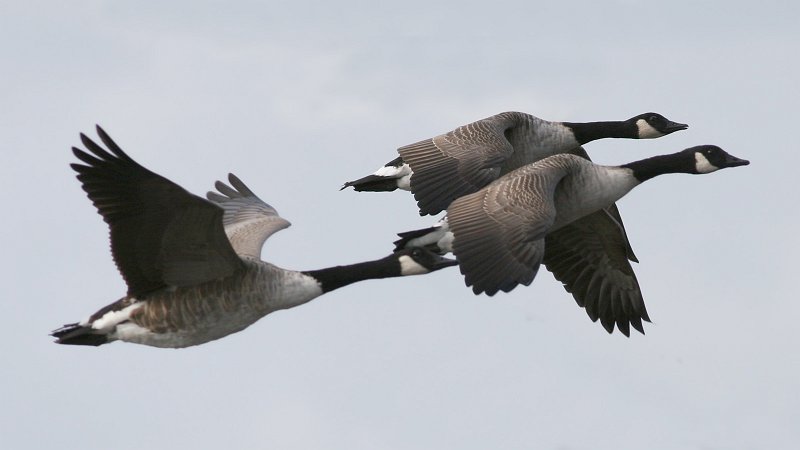Spring must be coming. The Canada geese are on the move. We’re out for the morning walk. Dave is distracted. He stands riveted—big floppy lab ears cocked, nose pointing to the south—he hears the season’s first gaggle of Canada geese (Branta canadensis) flying overhead.
They may have been wintering south of here, and if so, they’ve been quiet about it. We’ll hear them passing by for much of the spring, on their way from here or points south to Canada.
Native to North America, Canada geese were lavishly abundant in the 18th and 19th centuries. Weighing up to 14 pounds, these large brown birds with their black head and neck and white cheeks and chin strap were easy game for hunters. Some years ago, we visited the Chesapeake Bay Maritime Museum in St. Michaels, Maryland, and saw the multiple barrel shotguns and sneak boats that illegal hunters used to “harvest” them on the Chesapeake Bay. Slipping silently into the middle of the flock in his sneak boat, the hunter would let off one giant blast of his shotgun and kill dozens of birds at once. This was illegal, of course, but all the same, it contributed to the near extinction of the largest subspecies of Canada geese by the middle 1900s. A small population of these big birds was discovered in 1962, and under protective laws and game conservation efforts, they have reestablished in North America.
In early America, they summered in northern Canada, monogamous pairs raising their brood of from two to eight goslings each year. As a family, they would migrate up to 2500 miles south to find suitable winter quarters, and then return to their ancestral breeding grounds in the spring to raise another brood.
The world has changed since they were reestablished, though. The winters are becoming warmer, and the abundance of feeding options is increasing. Geese eat grass, and suburban yards, farm fields, golf courses and parks have provided new opportunities for ground foraging. They know how to stay warm in winter, so with abundant food, they often don’t bother to make that long flight south. Instead, they overwinter in much more northerly locations than of old. This does not always please the owners of said lawns and golf courses, because geese tend to leave their calling cards in abundance where they feed.
As primarily herbivores (plant-eaters) they have specialized digestive tracts that allow them to eat lots of plant material like grass, process what they can readily get out of it, and then move the rest of the undigestible fibers out to make room for more.
They have other adaptations as well that suit them to their environment. Geese have a waterproof coat of outer feathers which they maintain by spreading oil from a gland at the base of their tail over all the feathers. This oil helps keep the outer feathers waterproof and, as an added bonus, has components that in ultraviolet light turn into vitamin D3 which they ingest the next time they preen those feathers. They have webbed feet, with webbing filling the spaces between their three front-facing toes. This helps them swim efficiently and walk on soft mud without sinking in.
Compared to other birds that we see on Owl Acres, Canada geese are huge. They stand three feet tall and weigh as much as a Thanksgiving turkey. To compensate for that weight, they have long, powerful wings spanning up to six feet. They have to run across the water to get airborne, but once up, their strong wingbeats can sustain them for up to 600 miles in a day during migration.
Owl acres doesn’t have much habitat for these big brown birds with their wide, flat bills, black, fan-shaped tails and brown backs and wings. But we’ll claim them as they fly over, honking merrily, looking for ponds and lakes to settle on.
Photo by Ken Billington

1 comment